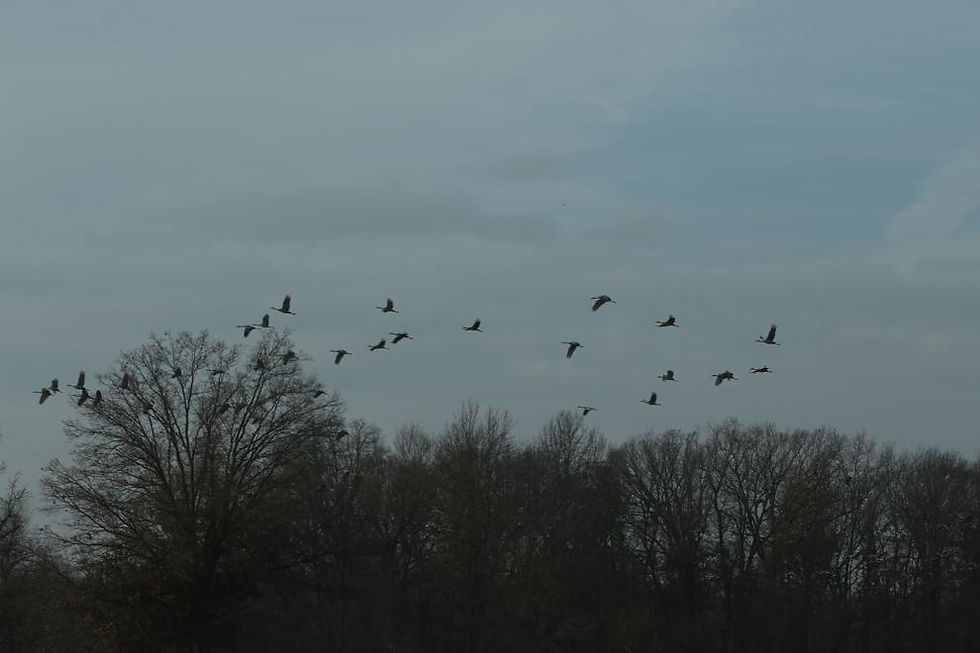Thousands of sandhill cranes travel over Northwest Indiana during annual migration south
- devoremolly
- Feb 25, 2023
- 4 min read
Published in the Times of Northwest Indiana
Dec. 3, 2022

MEDARYVILLE — Two dark spots flew across the cloudy sky — the first sandhill cranes of the day.
At 6:47 a.m. Central Time, four more trickled out of the marsh. Nick Echterling scribbled down a number every few minutes: three, five, one, four, nine, eight, two...
"This is the boring part," explained Echterling, property manager for the Jasper-Pulaski Fish and Wildlife Area. "The wait starts off slow."
By 8 a.m. he was ready to flush the remaining birds out of the wetland to get an accurate count.
As golden rays of sun poked through the clouds, hundreds of sandhill cranes filled the sky.
“Nothing sounds like a sandhill crane," Echterling remarked.
Sandhill crane hot spot
Split between Jasper and Pulaski Counties, and between Eastern and Central time zones, the Jasper-Pulaski Fish and Wildlife Area turns into a birding hot spot every fall. Visitors travel from all across the Midwest, and even the country, to witness the thousands of sandhill cranes that stop at the park during their annual migration.
Every Tuesday at dawn, five white Department of Natural Resource trucks take their posts around the wildlife area's some 1,000 acres of wetland habitat. DNR staff armed with yellow legal pads keep their eyes trained on the sky.
Counting cranes is an "acquired skill," Echterling admits. It's easy to count the early birds by hand, but as the morning drags on, clouds of cranes fill the sky.
Sandhill cranes tend to travel in smaller family groups, so counters break the large flocks into smaller chunks.
A little after 9 a.m., the five counters met back at the main office and compared notes — 24,208 cranes. Lower than last week's count of 31,975, but still, one of the largest concentrations of roosting sandhill cranes in the country.
Decades of overhunting and habitat degradation caused populations to dwindle. According to the annual crane count in 1979, the eastern population of greater sandhill cranes was just 14,385. As of 2020 the population had rebounded to 94,879, Echterling said.
“It’s pretty neat when we see 30,000 cranes, that's one-third of the population we have here on the property," Echterling said.
The eastern population of greater sandhill cranes nests in Canada, Minnesota and Wisconsin. Every winter the cranes travel some 2,000 miles to Florida or Georgia. Though the birds will stop two or three more times during the migration, Echterling said the groups won't be as concentrated.
Jasper-Pulaski's geographical convenience, ample habitat and surrounding farmland make it the perfect pit stop. According to Audubon Great Lakes, nearly the entire eastern population greater sandhill cranes depend on the marsh wetlands of Jasper-Pulaski during their southbound migration. The area has been designated a Global Important Bird Area by the National Audubon Society.
The cranes, who roost in shallow water, know it is time to head south when the freeze begins. Jasper-Pulaski will start seeing cranes at the end of September and will continue to see them through December, though the population tends to peak the last week of November. The wildlife area hosts a constant cycle of cranes, each one staying a week or two.
Every morning the birds visit nearby farms, feeding on leftover corn and soybeans, putting on a layer of fat before the long winter.
Though sandhill cranes will travel through the area again come spring, Echterling said, the birds don't stop for as long because they are in a rush to make it to their breeding grounds.
This fall, the wildlife area has seen more cranes than the year before, though they have not reached their 2020 peak of about 36,000.
“If you google sandhill cranes in Indiana, Pulaski comes up first,” said Mike Evancho, a birder who traveled to the wildlife area from Indianapolis.
However, Jasper-Pulaski was not always known as a sandhill crane oasis.
Back from the brink
Up until the 1970s, hardly any cranes stopped at Jasper-Pulaski.
Once the largest wetland in the country, the nearby Kankakee Marsh was drained and the Kankakee River was straightened to create farmland. In the 1970s and 80s, Jasper-Pulaski began restoring the area's wetlands, initially to create habitat for Canada geese. Gradually, cranes started roosting there too.
Today, all of the wetlands are carefully maintained with the aid of culverts, levees and other water control structures, ensuring the cranes always have enough habitat.
Since the mid-1960s, sandhill crane populations have been increasing at an annual rate of 5%, according to the North American Breeding Bird Survey. However, some subspecies remain endangered.
Climate change has also begun to impact cranes.
Echterling said the sandhill cranes that come through Jasper-Pulaski fall into two categories: calendar birds, who migrate as soon as the date indicates it's fall, and weather birds, who wait until dropping temperatures force them south.
“Thousands of years of evolution set that calendar for them," Echterling said. "The calendar and the weather used to be more aligned."
As falls become warmer, the peak migration occurs later and later. The "procrastinator group" of cranes is growing Echterling said.
A National Audubon Society study estimates that a temperature increase of 3 degrees Celsius could result in sandhill cranes losing over a third of their North American range.
Maintaining healthy sandhill crane populations is important both for biodiversity and because of the waterfowl's cultural importance. Sandhill cranes are one of the oldest living species of birds; researchers have found fossils dating back 2.5 million years.
Echterling said he's found "people are very drawn to cranes."
With 7-foot wingspans and heights of 4-to-5-feet, a mass migration of sandhill cranes is "just not something you see every day," Evancho said as he continued on his journey through Jasper-Pulaski, camera at the ready.



Comments